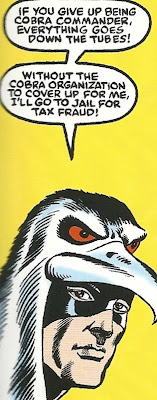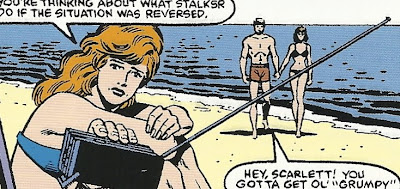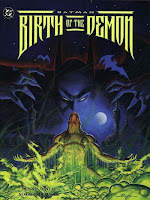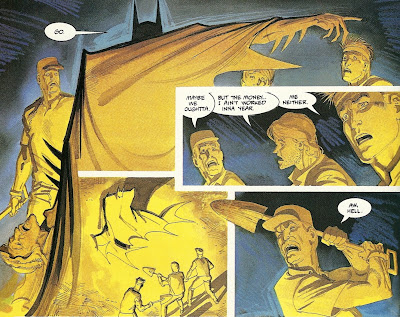Fortunately/unfortunately, they were having a year-end 20% off graphic novel sale, so I ended up buying a whole bunch of stuff I wouldn't normally have purchased, but that was on my too-read list. Here, then, are all the comics I bought at the comic shop this week...
 Aquaman #4 (DC Comics) Geoff Johns and Ivan Reis conclude their first arc of the relaunched Aquaman with title character exterminating the man-eating humanoids called The Trench that he's been fighting when not exhibiting an adolescent-like concern with whether or not people think he's cool. To Johns' credit, Aquaman realizes it's not like he's just squishing bugs here, and that he's faced with an extremely difficult decision of essentially choosing to let one group (The Trench) die in order to save another (the humans they were attempting to feed on). Rather than having to have Aquaman make a choice, Johns allows fate to intervene, and fate chooses us over the monsters.
Aquaman #4 (DC Comics) Geoff Johns and Ivan Reis conclude their first arc of the relaunched Aquaman with title character exterminating the man-eating humanoids called The Trench that he's been fighting when not exhibiting an adolescent-like concern with whether or not people think he's cool. To Johns' credit, Aquaman realizes it's not like he's just squishing bugs here, and that he's faced with an extremely difficult decision of essentially choosing to let one group (The Trench) die in order to save another (the humans they were attempting to feed on). Rather than having to have Aquaman make a choice, Johns allows fate to intervene, and fate chooses us over the monsters.Somewhat ironically, this story couldn't have been told in quite the same manner that it was if Johns hadn't changed Aquaman's powers to the extent he did. In the first issue, Aquaman is offended that people thinks he "talks" to fish, and he makes it clear that he's not communicating with them so much as psychically dominating them, hijacking their nervous systems and controlling them.
There's a scene where the Trench try to explain themselves to Aquaman while fighting him, and the hero laments not being able to understand them. "I wish we could talk," he says, "I wish I could make you understand, I can't allow you to use us as food." Pre-reboot Aquaman could have done that with his powers, but the new, Savage Aquaman has to resort to deadly violence, even if he does regret having to do so.
It's worth noting that this issue has 21-story pages instead of the now-customary 20, and includes a four-panel "Coming Up This Year in Aquaman teaser that is essentially a 22nd page, giving readers a heads-up that the cause of Atlantis' seeking will be explored starting with the next issue. (Which seems to be another very clear case of a "New 52" title evidencing a hard continuity reboot, in opposition to what was originally said about the initiative keeping the original continuity with a few tweaks.)
 Captain America & Bucky #625 (Marvel Entertainment) Writer James Asmus and artist Francesco Francavilla join co-plotter Ed Brubaker for the second story arc of the new series, which has an issue in the low 600s already because, um, Marvel, I guess. The book jumps forward in time to the present, then back to the late '40s to introduce Captain America II and Bucky II, whom the president charged with secretly filing in for the dead originals, so as not to demoralize the country, then forward again.
Captain America & Bucky #625 (Marvel Entertainment) Writer James Asmus and artist Francesco Francavilla join co-plotter Ed Brubaker for the second story arc of the new series, which has an issue in the low 600s already because, um, Marvel, I guess. The book jumps forward in time to the present, then back to the late '40s to introduce Captain America II and Bucky II, whom the president charged with secretly filing in for the dead originals, so as not to demoralize the country, then forward again. The new Cap and Bucky are pretty new to me—I think I've read maybe one other story to feature 'em before—so I was interested in meeting them, although I wonder if some of this will seem like an unnecessary retread to more experienced Cap fans. In the present, the original Captain America, Steve Rogers, teams up with the grandson of the late Cap II and the original Human Torch to begin investigating an attack a Golden Age villain seemingly initiated on the still-living but rather elderly Bucky II. Also, there's a Bucky I clone or android or something on the last page.
It's pretty hectic and confusing in summary, but its an engaging and exciting sort of confusion when read. It helps that Francavilla is one of the greats, and is, in fact, so good that I don't even miss Chris Samnee, the artist he replaces. Given that I started picking this book up to see Samnee's art on a monthly basis, I consider that fairly high praise.
 Classic G.I. Joe Vol. 7 (IDW) This trade collects issues #61-70 of Marvel's G.I. Joe: A Real American Hero series, comics originally published between 1987-88. This would be have been getting pretty damn near the time little Caleb stopped playing with G.I. Joes—in this volume, I see appearances by only about four or five action figures I used to have—but I'm still fascinated by these comics, which were produced using characters and concepts during a time when I was absolutely head over heels in love with those characters and concepts, but before I had any real interest in reading comics. Now I've lost that sort of obsessive interest with the characters, but feel about comics the way I used to feel about G.I. Joe.
Classic G.I. Joe Vol. 7 (IDW) This trade collects issues #61-70 of Marvel's G.I. Joe: A Real American Hero series, comics originally published between 1987-88. This would be have been getting pretty damn near the time little Caleb stopped playing with G.I. Joes—in this volume, I see appearances by only about four or five action figures I used to have—but I'm still fascinated by these comics, which were produced using characters and concepts during a time when I was absolutely head over heels in love with those characters and concepts, but before I had any real interest in reading comics. Now I've lost that sort of obsessive interest with the characters, but feel about comics the way I used to feel about G.I. Joe.Larry Hama's scripting is still superior, only semi-silly army guy and ninja soap opera, but man, the art in these things is rough, floating just below "awful' and just above "unreadable." It's also incredibly lazy for a a book based on a toy line, as characters will refer to things like, say, their jacket or their shoes, when they are drawn without a jacket and barefoot. Stuff like that. The covers were all pretty great, but the interiors are nothing any of these guys can be too terribly proud of (And there are some pretty great artists involved, like pencil artists Ron Wagner and Marshall Rogers, and inker...Russ Heath? For real?!)
IDW's presentation doesn't do it any favors, either. According to the back, the comics were all re-mastered for color, but the coloring is pretty bad, in some pages near the back of the book, blobs of color overtake the lines of the figures, resembling the results of an exceptionally bad kindergartener with crayons who can't quite stay in the lines (Maybe I had a bum copy though...) I do hesitate to say anything bad about IDW's doing these books though, as I super-happy they decided to reprint these comics after Marvel quit doing so, and I hope they actually do end up printing the whole run, right up until those crazy-looking early '90s issues.
I think my favorite bits in this particular volume were those featuring Raptor (I had his action figure!), who has trained hawks and falcons and whose costume is a Hawkman-like cowl that sits atop his head, a feathered cape he usually wears over bare shoulders, and talons on his feet.
He's an accountant.
 And he apparently dresses like that, like, all the time, not just when in the field fighting G.I. Joe with trained birds. For example, after driving to San Francisco, while wearing his cape and talon shoes, he uses the pay phone:
And he apparently dresses like that, like, all the time, not just when in the field fighting G.I. Joe with trained birds. For example, after driving to San Francisco, while wearing his cape and talon shoes, he uses the pay phone:
And the worst part? The worst part is probably issue #63, in which Hama has couples Snake Eyes and Scarlett and Flint and Lady Jaye vacationing in Grenada together. There are multiple panels of Lady Jaye in a skimpy bikini, and artist Ron Wagner draws her either far, far in the background...

 ...or, in the single panel where she's shown in a medium-shot, stupid Flint's stupid elbow is blocking our view of her...
...or, in the single panel where she's shown in a medium-shot, stupid Flint's stupid elbow is blocking our view of her... Damn you, Flint!
Damn you, Flint! Full Metal Alchemist Vol. 26-27 (Viz Media) This is it! The penultimate and ultimate volumes of Hiromu Arakama's feverishly addictive adventure series in which brother alchemists Edward and Alphonse Elric search to unlock the mysteries of the Philosopher's Stone and find themselves key players in a gigantic plot that gets bigger and bigger, as more and more players are introduced, and grander and grander schemes are revealed.
Full Metal Alchemist Vol. 26-27 (Viz Media) This is it! The penultimate and ultimate volumes of Hiromu Arakama's feverishly addictive adventure series in which brother alchemists Edward and Alphonse Elric search to unlock the mysteries of the Philosopher's Stone and find themselves key players in a gigantic plot that gets bigger and bigger, as more and more players are introduced, and grander and grander schemes are revealed. I wasn't 100% satisfied with the conclusion, which I think suffered a bit from a Return of The King (the movie) like pile-up of too many endings, and re-sets the Elric brothers with a new status quo that doesn't necessarily end their story and seems a little too easy to continue. The journey to those conclusions was amazing—this has ended up being one of my favorite manga reading experiences—and Arakawa did a fairly astounding job of working his way up to the final battle, in which the Dwarf in the Flask essentially kills the whole world and absorbs God, and having the heroes fight back from such a total defeat.
Everything gets tied up rather neatly too, although, as I said, some of the plot threads could have used a tad more finality...that, or more ambiguity, I guess. It just seemed a little too open. But maybe it was just weird to see the narrative return to something more quiet after what was probably about 800 consecutive pages of almost every single character in a cast of dozens battling for the fate of the world.
I'd highly recommend this manga series. (It's a lot better than the anime, too, if that's your only exposure).
 Quality Companion (TwoMorrows) Okay, I'm not actually done reading this yet, but I'm including it here anyway, as I purchased it. I was pretty excited when I first heard about it, and actually considered trying to get a review copy just so I could read it without having to pay for it (at $32, it ain't cheap). But it was 20% off, and seeing it right on a shelf in front of me, well, I couldn't resist. Quality was home of some of my favorite Golden Age superheroes, as regular readers no doubt know, including Plastic Man, Uncle Sam and The Red Bee (they, and most of the rest of Quality's characters were eventually purchased by DC Comics and gradually folded into the fabric of the DCU...although after the New 52-boot, I'm not sure how many of them are actually even still around. I know there are books using the names Blackhawks and The Ray, and I heard there was a one-panel Plas cameo in Justice League International. Is that it so far? Geoff Johns mentioned using Lady Luck in his Justice League book after its initial six-part story arc wraps up...)
Quality Companion (TwoMorrows) Okay, I'm not actually done reading this yet, but I'm including it here anyway, as I purchased it. I was pretty excited when I first heard about it, and actually considered trying to get a review copy just so I could read it without having to pay for it (at $32, it ain't cheap). But it was 20% off, and seeing it right on a shelf in front of me, well, I couldn't resist. Quality was home of some of my favorite Golden Age superheroes, as regular readers no doubt know, including Plastic Man, Uncle Sam and The Red Bee (they, and most of the rest of Quality's characters were eventually purchased by DC Comics and gradually folded into the fabric of the DCU...although after the New 52-boot, I'm not sure how many of them are actually even still around. I know there are books using the names Blackhawks and The Ray, and I heard there was a one-panel Plas cameo in Justice League International. Is that it so far? Geoff Johns mentioned using Lady Luck in his Justice League book after its initial six-part story arc wraps up...)The Companion is a compilation of several types of books I would like to read, all rolled into one. There are nine original comics reprinted (featuring The Ray and Black Condor by Lou Fine, Midnight by Jack Cole and stories starring Phantom Lady, Human Bomb, Uncle Sam, Firebrand, Wildfire and Madam Fatal), there's some Golden Age history (Quality was home to some of the era's very best artists, including Fine, Cole and Will Eisner), and encyclopedia-like entries on the various characters, which take into account everything from their original adventures up through their 2010-ish status at DC (There are entries on all the various Ray characters up until the one that appeared in the Jimmy Palmiotti and Justin Gray-written Freedom Fighters series, but no mention of the one who just appeared in a new Ray miniseries), and encyclopedia-like entries on the artists at Quality.
There are also some Q-and-A interviews with the DC writers who made most use of the Quality characters—Len Wein, Roy Thomas, James Robinson—but I haven't read any of those yet. I've basically been flipping through and reading an entry here and a chapter there.
So, um, I can't really offer much of a review, per se, other than that this is a fantastic book, allowing for several of my favorite types of reading experiences between a single set of covers, and covering some of my favorite creators and characters in the history of comics.
Wonder Woman Chronicles Vol. 2 (DC) I've already read all of these stories thanks to DC's fancy-schmany archive editions, but I would never be able to afford them. That's why I love the hell out of these Chronicles reprints. My only complaint is the Wondy ones don't come out fast enough, and there aren't any Plastic Man or Captain Marvel ones...









































